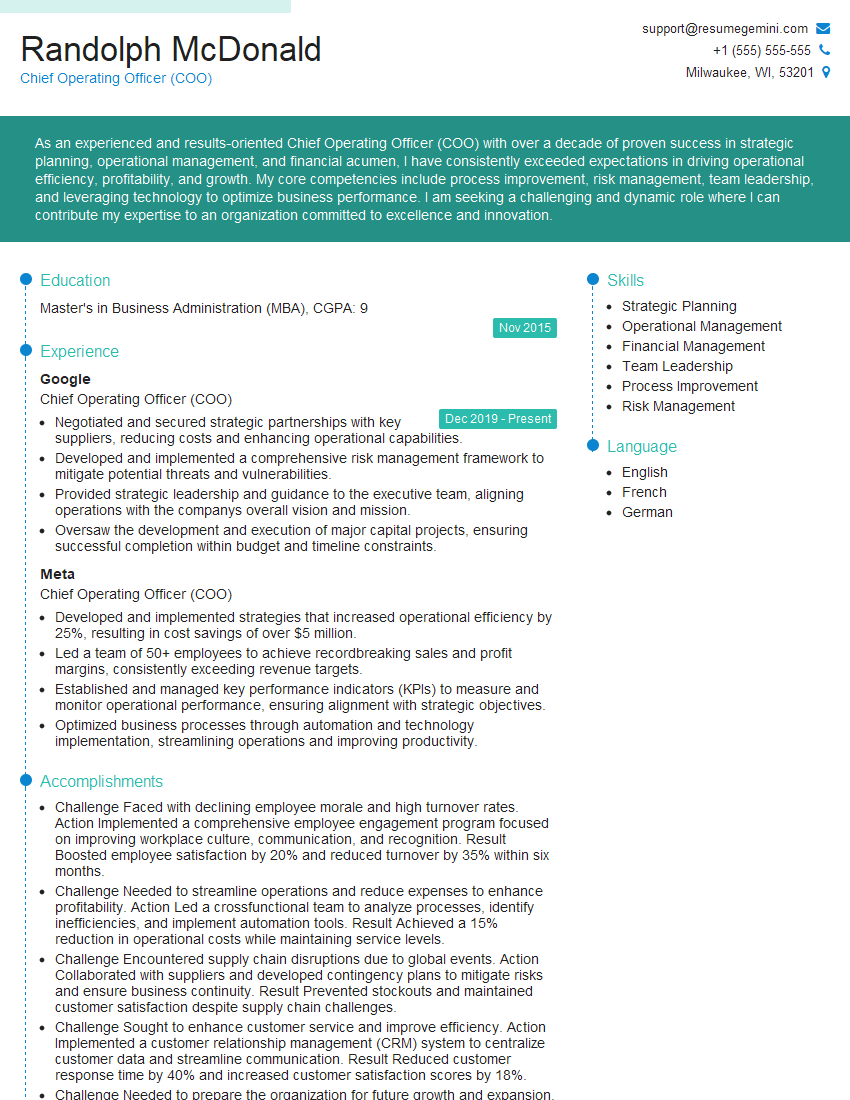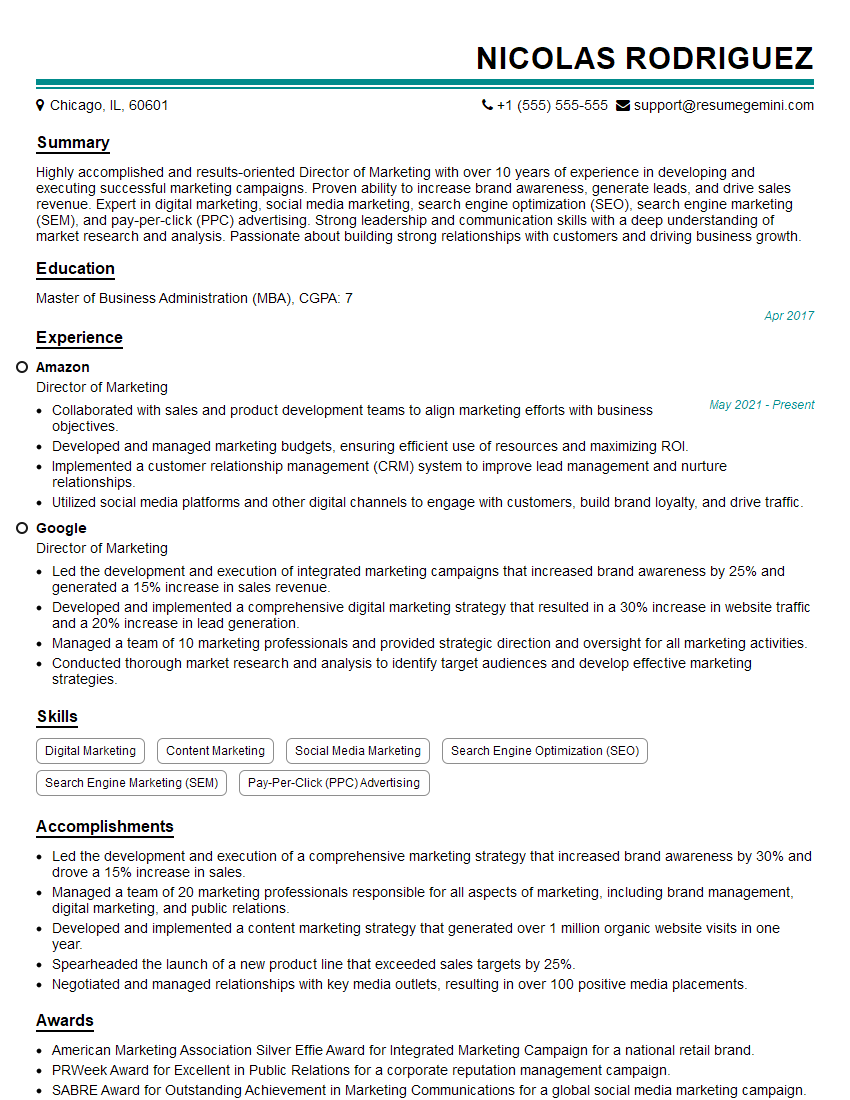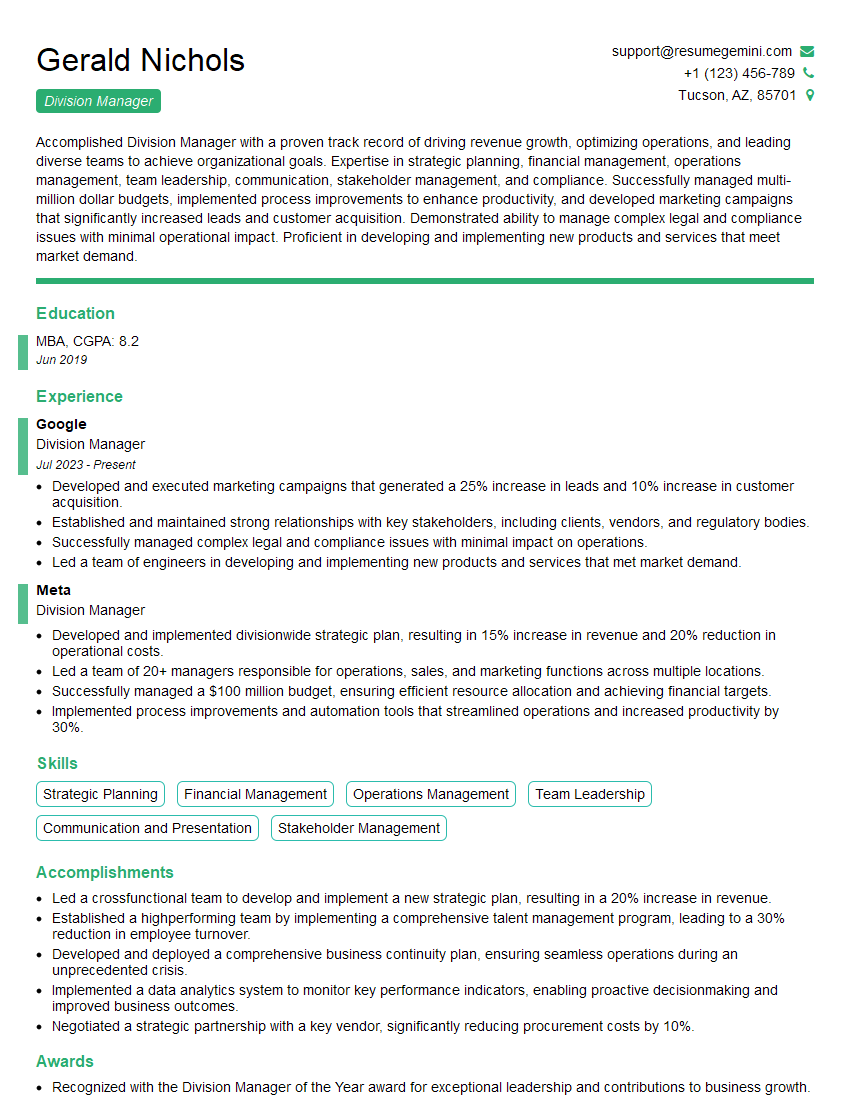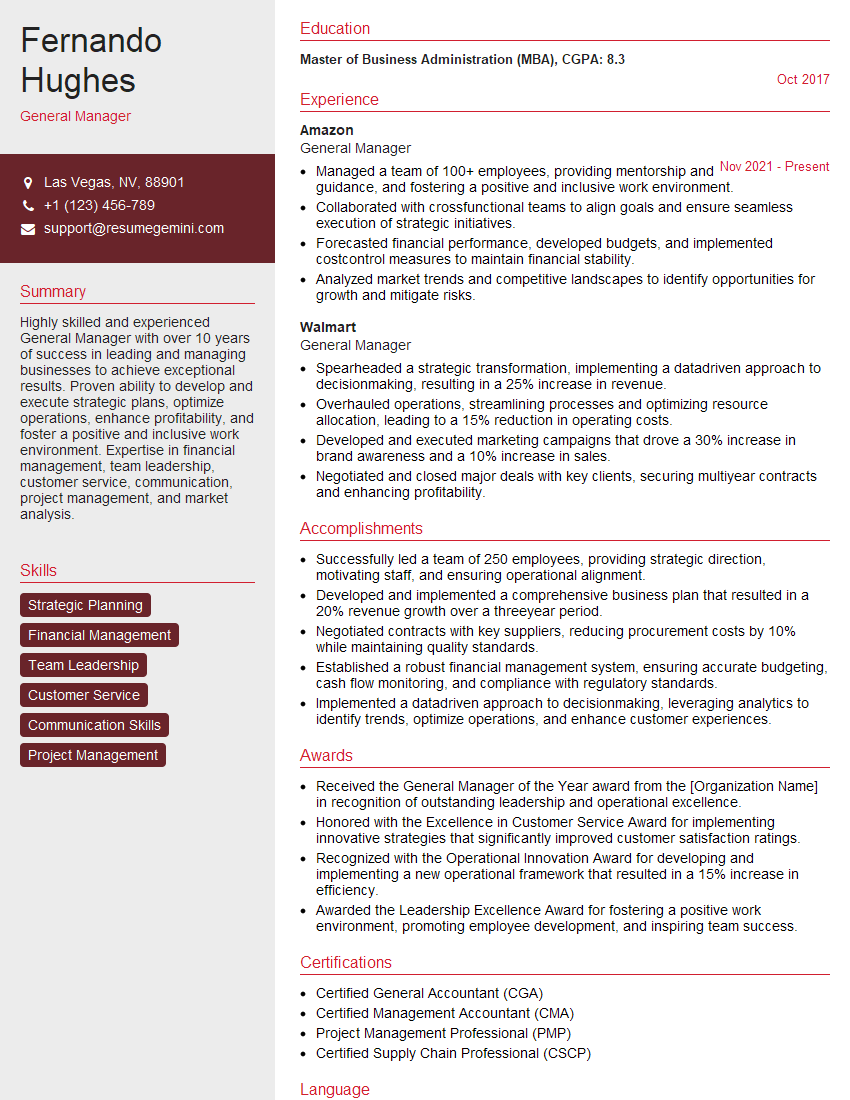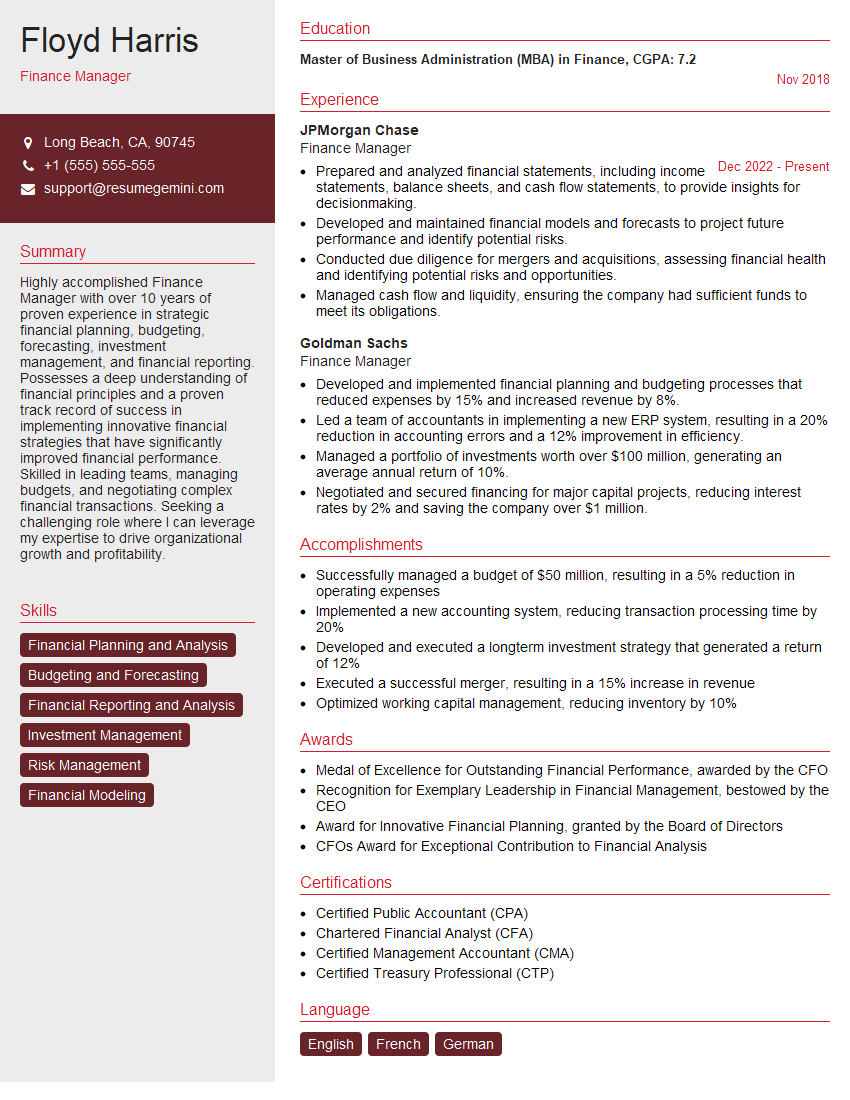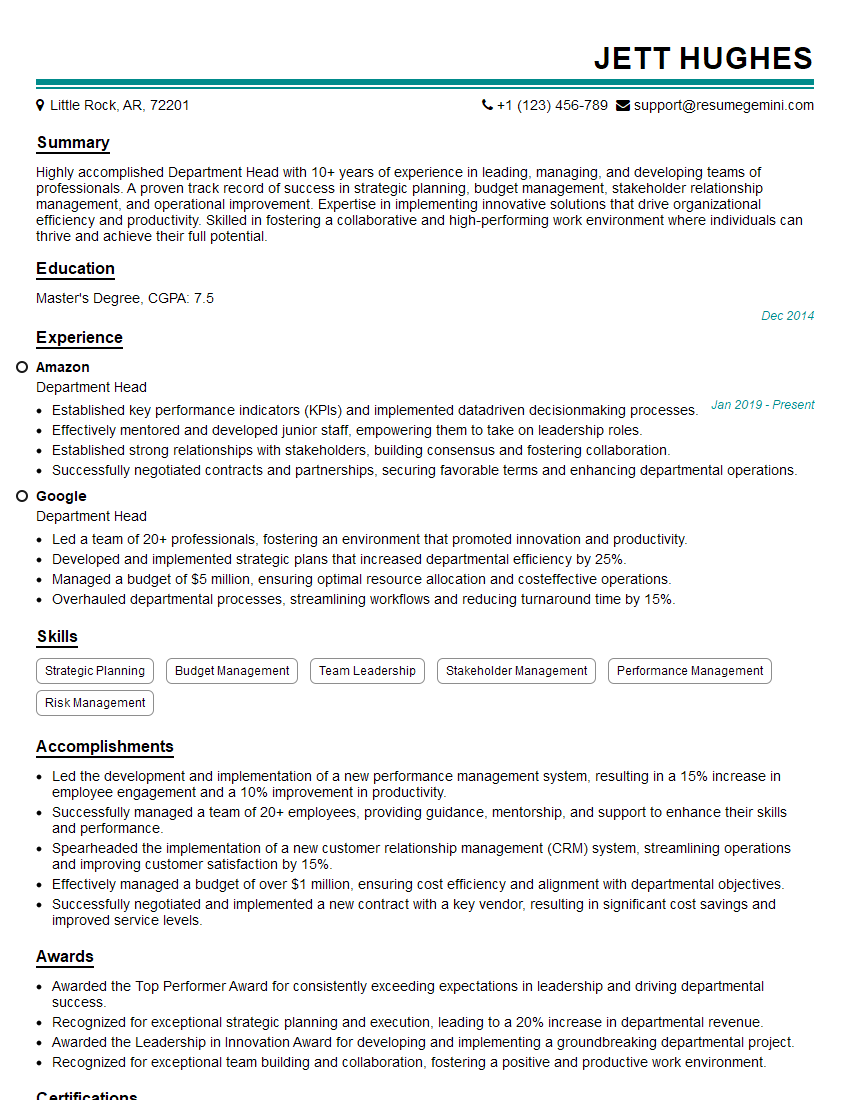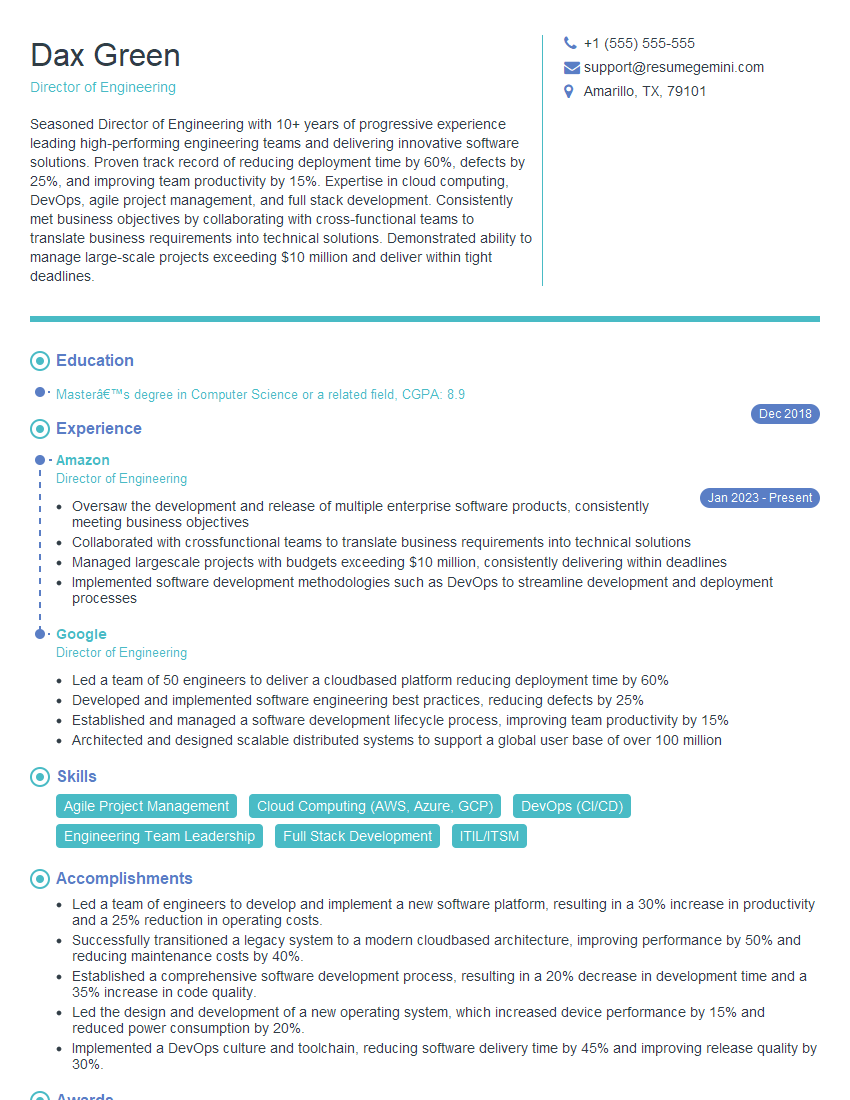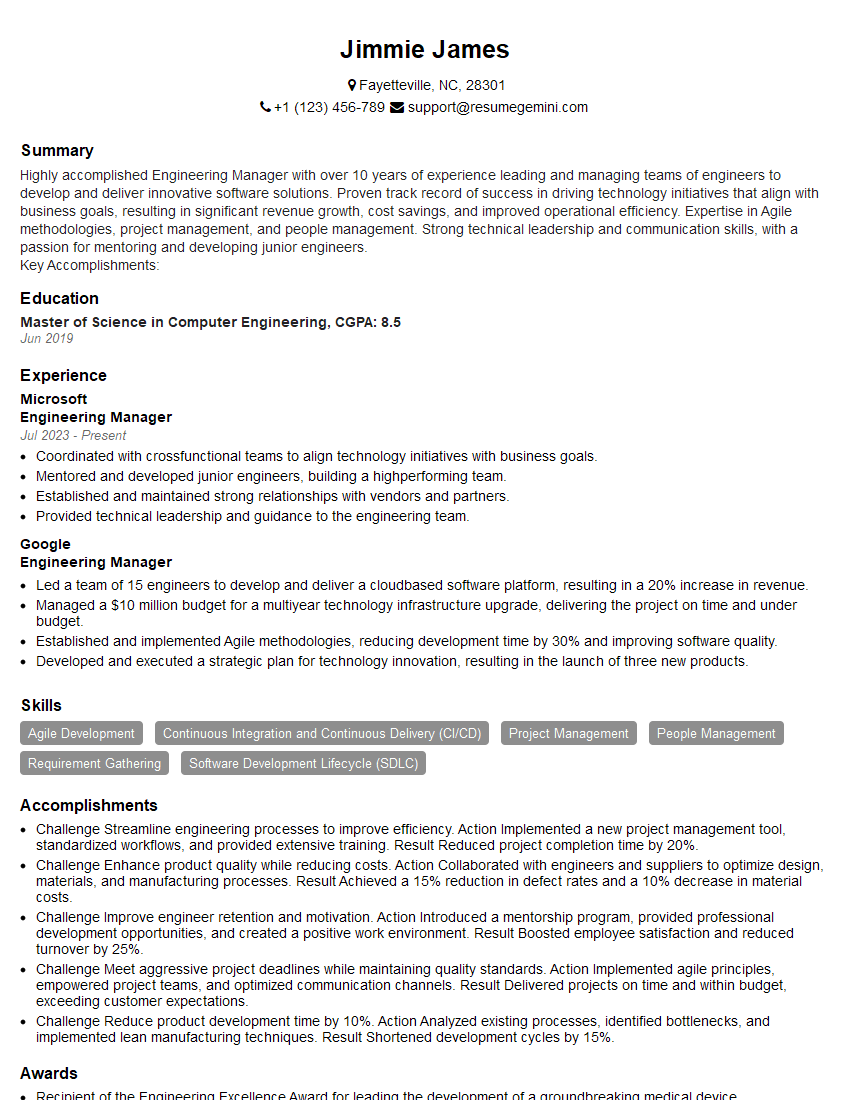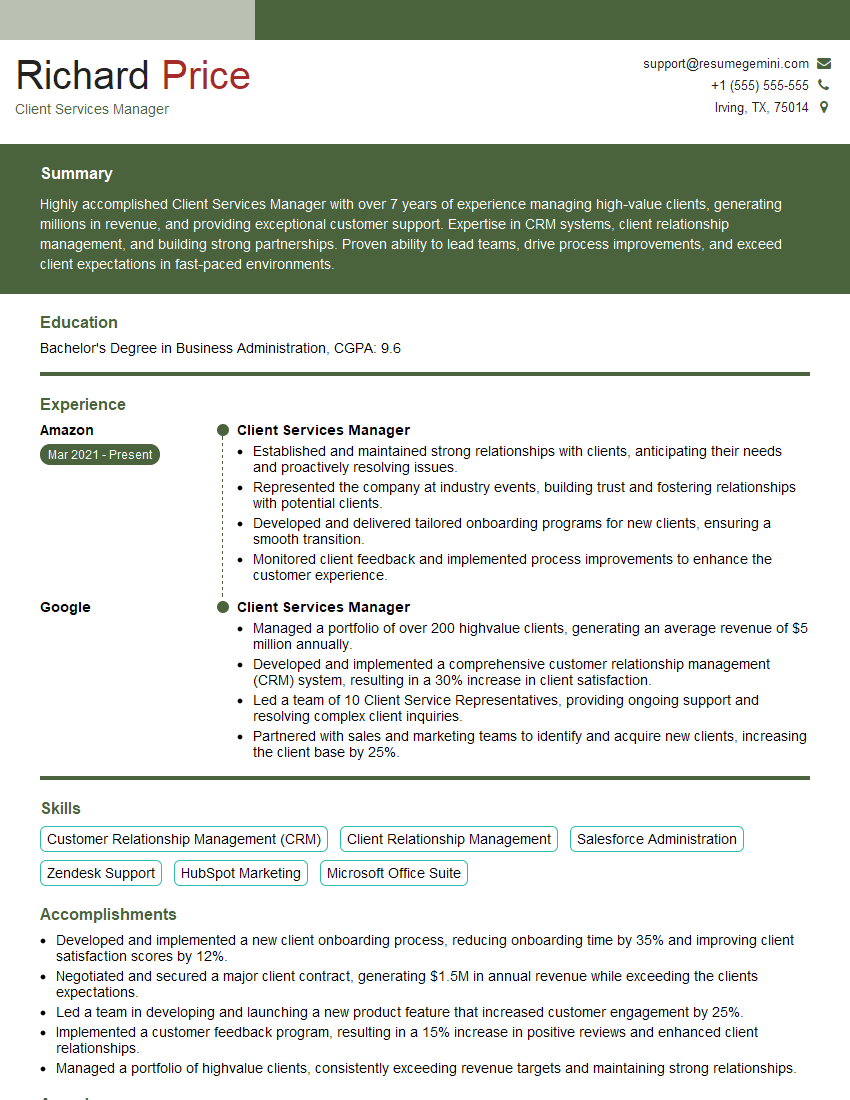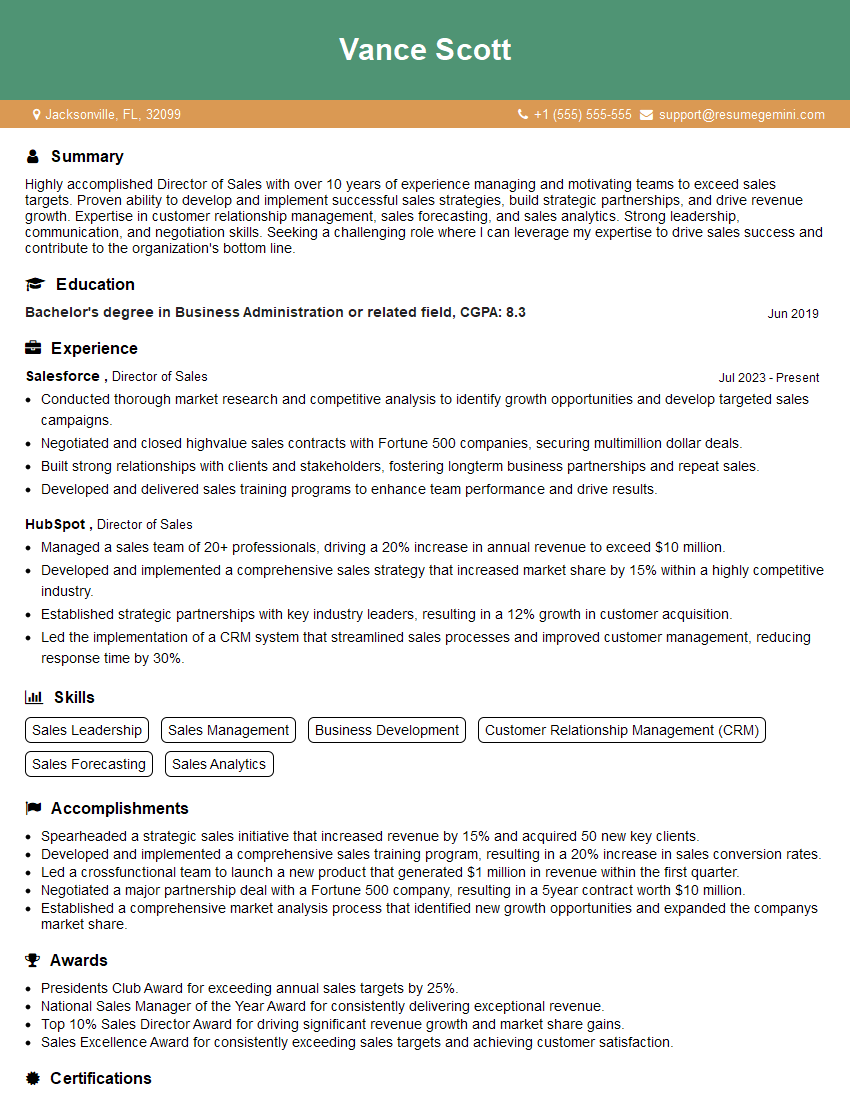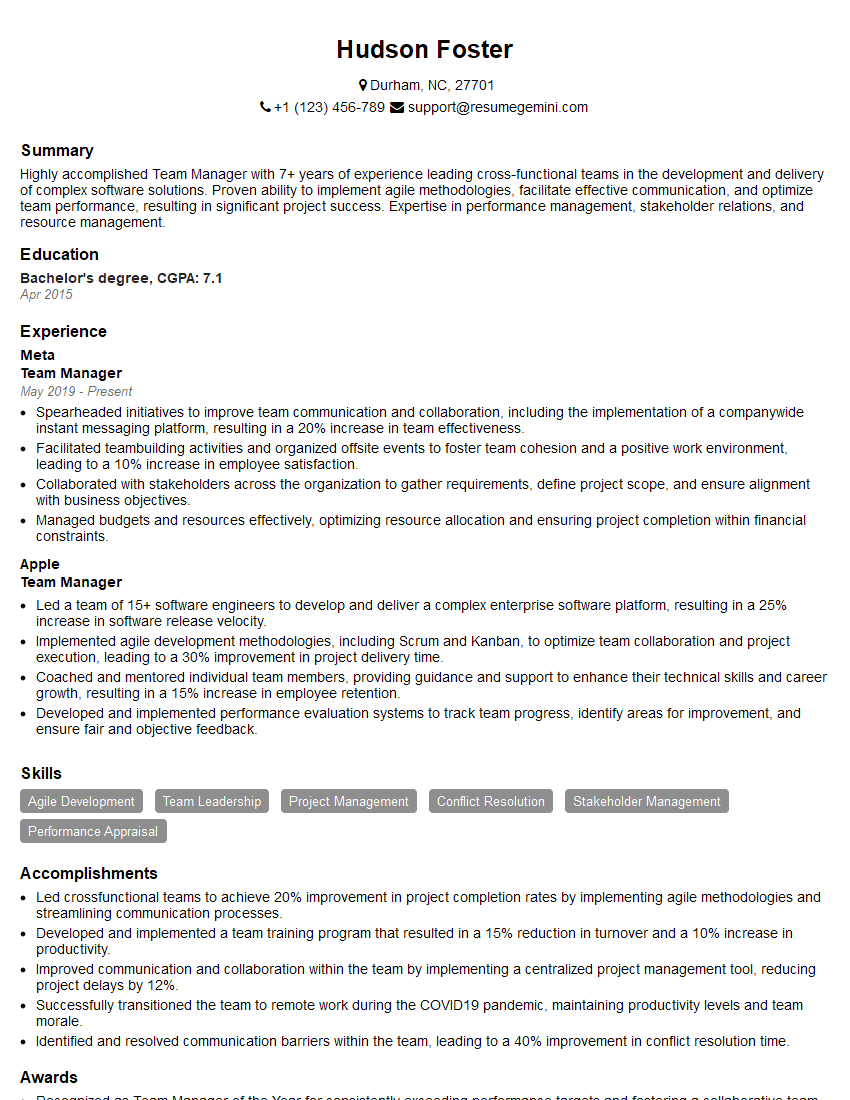Are you ready to stand out in your next interview? Understanding and preparing for Managing Teams interview questions is a game-changer. In this blog, we’ve compiled key questions and expert advice to help you showcase your skills with confidence and precision. Let’s get started on your journey to acing the interview.
Questions Asked in Managing Teams Interview
Q 1. Describe your experience in building and motivating high-performing teams.
Building a high-performing team is like assembling a winning sports team – it requires identifying the right players, fostering collaboration, and providing clear direction. My approach starts with a clear understanding of the team’s goals and individual strengths. I carefully select team members with complementary skills and personalities, ensuring a diverse range of perspectives. Then, I focus on fostering a culture of trust and psychological safety where everyone feels comfortable contributing their ideas and taking risks. Motivation is key, and I achieve this through:
- Clear expectations and recognition: I ensure every team member understands their roles and responsibilities and consistently recognize and reward their contributions, both big and small. This could be through formal performance reviews, informal praise, or even small gestures like a team lunch.
- Empowerment and autonomy: I believe in delegating responsibility and providing team members with the authority to make decisions within their area of expertise. This fosters ownership and increases motivation.
- Open communication and feedback: Regular check-ins, both individually and as a team, ensure open dialogue. I encourage feedback, both positive and constructive, and demonstrate a willingness to listen and learn from my team.
- Continuous learning and development: Investing in team members’ professional growth through training, mentoring, or providing opportunities for challenging assignments significantly boosts morale and performance.
For example, in my previous role, we faced a significant backlog. By empowering team members to suggest process improvements and providing them with the training they needed to implement Agile methodologies, we improved efficiency by 40% within six months, leading to higher morale and significantly improved project delivery.
Q 2. How do you delegate tasks effectively within a team?
Effective delegation is about entrusting tasks to the right people at the right time. It’s not just about offloading work; it’s about empowering individuals and building their capabilities. My approach involves:
- Assessing individual skills and strengths: I carefully evaluate each team member’s capabilities and match tasks to their strengths. This ensures both successful task completion and employee growth.
- Setting clear expectations and deadlines: Tasks should be clearly defined with specific outcomes, deliverables, and timelines. Ambiguity leads to confusion and poor performance. I use SMART goals (Specific, Measurable, Achievable, Relevant, Time-bound).
- Providing necessary resources and support: Team members need the tools and information to succeed. This includes providing access to necessary software, data, and mentoring as needed.
- Monitoring progress and offering guidance: Regular check-ins allow me to provide support, address challenges, and ensure the task is on track. This doesn’t mean micromanaging; it’s about ensuring success and providing assistance if needed.
- Providing feedback and recognition: After task completion, I provide constructive feedback, focusing on both successes and areas for improvement. This reinforces positive behavior and promotes learning.
For instance, I once delegated a complex project to a junior team member who possessed the necessary technical skills but lacked experience in project management. By providing clear guidelines, regular support, and access to relevant resources, they successfully completed the project, exceeding expectations and significantly boosting their confidence and skills.
Q 3. Explain your approach to conflict resolution within a team environment.
Conflict is inevitable in any team environment; however, effective conflict resolution is crucial for maintaining productivity and team morale. My approach focuses on creating a safe space for open dialogue and finding mutually acceptable solutions. I employ the following steps:
- Identify the root cause: The first step is to understand the underlying issue fueling the conflict. This often requires active listening and seeking input from all involved parties.
- Facilitate a collaborative discussion: I create a neutral environment where team members can express their perspectives without interruption. I encourage active listening and empathy.
- Focus on finding solutions, not assigning blame: The goal is to resolve the conflict, not to determine fault. I guide the discussion toward identifying common goals and exploring mutually acceptable solutions.
- Document agreements and follow up: Once a solution is reached, I ensure that it’s documented clearly and followed up to monitor progress and address any emerging issues.
In one instance, two team members had a significant disagreement regarding a project’s approach. By facilitating a structured discussion and focusing on their shared objective—project success—we identified a compromise that satisfied both parties. The project was completed successfully, and the team members developed a stronger working relationship.
Q 4. How do you measure team performance and identify areas for improvement?
Measuring team performance requires a multifaceted approach, incorporating both quantitative and qualitative metrics. I use a combination of methods to assess performance and identify areas for improvement:
- Key Performance Indicators (KPIs): These are quantifiable metrics that directly relate to the team’s goals. Examples include project completion rates, customer satisfaction scores, and defect rates.
- Qualitative assessments: This includes regular team meetings, feedback sessions, and 360-degree reviews to gather insights into team dynamics, communication effectiveness, and overall morale.
- Project post-mortems: After project completion, we conduct detailed analyses to identify what went well, what could be improved, and to learn from both successes and failures. This information is used to enhance future project performance.
For instance, in a past project, while our KPI of on-time delivery was met, the qualitative feedback indicated communication breakdowns. By addressing this weakness through improved communication protocols and team-building activities, we significantly improved future project collaboration and overall team performance in subsequent projects.
Q 5. Describe a time you had to manage a team through a significant challenge.
During a major system upgrade, our team faced a critical deadline and unexpected technical challenges. Initial attempts to resolve the issues were unsuccessful, leading to increased stress and decreased morale. My approach involved:
- Open communication and transparency: I held regular team meetings to keep everyone informed of the challenges and progress, fostering trust and managing expectations.
- Re-prioritization and resource allocation: We analyzed the situation and re-prioritized tasks to focus on resolving the most critical issues first. This involved reallocating resources and bringing in additional expertise where needed.
- Team empowerment and problem-solving: I encouraged the team to brainstorm solutions collaboratively. Empowering them to contribute ideas fostered ownership and boosted their motivation despite the pressure.
- Continuous learning and adaptation: We treated each challenge as a learning opportunity. After resolving the issues, we held a post-mortem to identify areas for improvement in our processes and prevent similar issues in the future.
Despite the initial setbacks, we successfully completed the upgrade on time and within budget. The experience reinforced the value of open communication, adaptability, and team empowerment in overcoming significant challenges.
Q 6. What strategies do you use to foster collaboration and communication within a team?
Fostering collaboration and communication within a team is crucial for success. My strategies include:
- Regular team meetings: These provide a platform for updates, discussion of challenges, and brainstorming solutions. I encourage open dialogue and active participation from all members.
- Collaborative workspaces: Utilizing tools like shared documents, project management software, and online communication platforms facilitates seamless information sharing and collaborative work.
- Team-building activities: Informal social events and team-building exercises help build relationships, enhance trust, and improve communication.
- Open-door policy: I encourage team members to approach me with any questions or concerns, creating a culture of open communication and accessibility.
- Clear communication channels: I establish clear and efficient communication channels to ensure information flows effectively, reducing confusion and misunderstandings.
For example, during a particularly complex project, the team used a collaborative project management tool which facilitated real-time task updates and provided a central repository for all project documentation. This dramatically improved transparency and team coordination, which was crucial in delivering the project on time and within budget.
Q 7. How do you handle underperforming team members?
Addressing underperformance requires a sensitive yet firm approach. My strategy involves:
- Identifying the root cause: I first determine if the underperformance stems from lack of skills, training, resources, or other factors. This often involves one-on-one conversations to understand the individual’s perspective.
- Providing support and guidance: I offer additional training, mentorship, or resources to address skill gaps or remove obstacles preventing successful task completion.
- Setting clear expectations and goals: I work with the team member to develop a clear performance improvement plan with specific goals, timelines, and metrics for success.
- Regular check-ins and feedback: I provide regular feedback, both positive and constructive, to track progress and address any emerging challenges. This includes providing regular support and encouragement.
- Performance improvement plan (PIP): In cases of persistent underperformance, a formal PIP may be necessary, outlining specific goals, expectations, and consequences of continued underperformance.
- Difficult conversations and possible termination: In cases where improvement is not seen despite implemented support, difficult conversations may be needed, possibly leading to termination of employment as a last resort.
I believe in providing ample support and opportunities for improvement before resorting to disciplinary action. My goal is to help team members succeed, but sometimes, despite best efforts, it becomes clear that a change is necessary for both the individual and the team.
Q 8. How do you onboard new team members and ensure their success?
Onboarding is crucial for new team members’ success. It’s more than just paperwork; it’s about integrating them seamlessly into the team and company culture. My approach involves a structured three-phase process:
- Phase 1: Pre-boarding (before Day 1): I send a welcome package with essential information like company policies, team introductions (with photos!), and a welcome video. I also set up their workstation and accounts beforehand, minimizing initial tech hiccups. This proactive approach sets a positive tone from the start.
- Phase 2: First Week Onboarding: This week focuses on team integration and role clarity. We have a formal onboarding meeting, covering the company’s mission, values, and their specific role and responsibilities. I introduce them to key stakeholders, and we establish clear communication channels and expectations. Shadowing senior team members and completing small, manageable tasks builds early confidence.
- Phase 3: Ongoing Support and Development (first 3 months): Regular check-ins are vital during the first three months. I provide constructive feedback, answer questions, and ensure they’re progressing well. I offer mentorship and identify any areas where additional training or support may be needed. We also set clear goals and milestones to track progress and celebrate successes. This fosters a sense of belonging and prevents them from feeling lost.
For example, when onboarding a junior developer, I assigned them a small, well-defined bug fix within the first week to build their confidence and give them practical experience within our codebase. By the end of the first month, they were fully integrated and contributing to the team’s projects.
Q 9. Describe your experience with performance management and providing feedback.
Performance management is a continuous process, not just an annual review. I utilize a combination of regular feedback, goal setting, and performance evaluations. I believe in providing feedback frequently, both positive and constructive, using the ‘sandwich method’ – starting with positive feedback, then addressing areas for improvement, and ending with another positive note. This approach makes feedback less daunting and more constructive.
I use the SMART goal framework (Specific, Measurable, Achievable, Relevant, Time-bound) to set clear expectations. This ensures we’re both on the same page regarding performance goals. Regular one-on-one meetings provide opportunities for open communication, addressing any roadblocks or concerns. Performance evaluations are used to summarize progress against goals, identify skill gaps, and create development plans.
For example, I once had a team member struggling with time management. Instead of criticizing, I worked with them to identify the root cause, creating a personalized action plan using a time-tracking app and prioritizing tasks based on urgency and importance. This collaborative approach resulted in significant improvement.
Q 10. How do you prioritize tasks and manage competing deadlines within a team?
Prioritizing tasks and managing competing deadlines requires a structured approach. I utilize several techniques, including:
- Prioritization Matrices (e.g., Eisenhower Matrix): Categorizing tasks based on urgency and importance helps focus on the most critical items first. This ensures that we address the most pressing needs before tackling less crucial tasks.
- Team Collaboration & Planning Sessions: Regular meetings, involving the entire team, facilitate open discussions about task dependencies and potential bottlenecks. This collaborative approach ensures everyone understands priorities and can contribute effectively.
- Agile Methodologies (e.g., Scrum, Kanban): These frameworks help break down large projects into smaller, manageable tasks, facilitating better tracking of progress and adaptation to changing priorities. Visual tools like Kanban boards provide transparency and allow for flexible task management.
- Time Blocking and Task Allocation: I allocate specific time blocks for different tasks and assign tasks based on team member skills and availability. This ensures optimal resource allocation and minimizes conflicts.
For instance, during a product launch, we utilized the Eisenhower Matrix to prioritize features based on their impact and deadline. This ensured we released the most critical features on time while managing expectations on less critical features.
Q 11. What tools and techniques do you use for project management?
My project management toolkit is diverse and adapts to the project’s needs. I leverage a blend of software and techniques:
- Project Management Software (e.g., Asana, Jira, Trello): These platforms provide centralized task management, progress tracking, and communication features, promoting team transparency and accountability.
- Communication Tools (e.g., Slack, Microsoft Teams): Real-time communication is vital, and these tools ensure everyone remains informed and connected.
- Agile Methodologies (Scrum, Kanban): As mentioned earlier, these help manage complexity and ensure iterative development.
- Gantt Charts: These visual representations of project timelines provide a clear overview of tasks and deadlines, aiding planning and progress tracking.
- Regular Status Meetings: Short, focused meetings keep everyone aligned on progress and address any roadblocks promptly.
For example, in a recent project, we used Jira to track bugs and feature development, using Scrum sprints to break down the work into manageable chunks. Regular stand-up meetings kept everyone informed about daily progress and any impediments.
Q 12. How do you ensure team members feel valued and supported?
Making team members feel valued and supported is paramount. My approach involves:
- Recognition and Appreciation: Regularly acknowledging and celebrating both individual and team achievements, both big and small, fosters a positive work environment.
- Open Communication and Feedback: Creating a safe space where team members can openly communicate their ideas, concerns, and challenges is crucial. Active listening and providing constructive feedback build trust and mutual respect.
- Mentorship and Development Opportunities: Investing in team members’ growth by providing training, mentorship, and opportunities for skill development shows investment in their long-term success.
- Work-Life Balance Support: Promoting a healthy work-life balance reduces burnout and fosters a more positive and productive team.
- Employee Assistance Programs (EAPs): Making resources available to address personal or professional challenges shows care for their well-being.
For example, I once organized a team outing to celebrate a project milestone, fostering camaraderie and demonstrating my appreciation for their hard work. We also implemented flexible work arrangements to improve work-life balance.
Q 13. How do you maintain team morale and motivation?
Maintaining team morale and motivation requires a multifaceted approach:
- Clear Communication and Vision: Keeping the team informed about the company’s goals and their contribution towards those goals fosters a sense of purpose and motivation.
- Team Building Activities: Organizing social events and team-building activities promotes camaraderie and strengthens team bonds.
- Regular Feedback and Recognition: Continuous feedback and regular appreciation for hard work maintain motivation and morale.
- Opportunities for Growth and Development: Providing opportunities for skill enhancement and career advancement motivates team members to strive for excellence.
- Addressing Conflicts Promptly and Fairly: Resolving conflicts fairly and promptly prevents negativity from impacting team morale.
For instance, during a challenging project, I organized weekly team lunches to build camaraderie and boost morale. I also ensured everyone had opportunities to share their ideas and contribute to problem-solving, fostering a sense of ownership and collaboration.
Q 14. How do you adapt your management style to different team members and situations?
Adaptability is key in team management. I believe in employing a situational leadership style, adjusting my approach based on individual team members’ needs and the specific situation. I assess each team member’s skill level, experience, and personality to tailor my approach.
For instance, I might provide more hands-on guidance to a newer team member, offering detailed instructions and frequent check-ins. With a more experienced team member, I might adopt a more delegative approach, offering support and guidance as needed but allowing them greater autonomy. In situations requiring quick decision-making, I might adopt a more directive approach, clearly outlining expectations and providing clear instructions. However, for complex problems needing creative solutions, I will encourage collaboration and brainstorming sessions.
This adaptability ensures I can effectively manage diverse teams and navigate various challenges, fostering a productive and supportive environment for everyone.
Q 15. Describe your experience with remote team management.
My experience with remote team management spans over eight years, encompassing various team sizes and project complexities. I’ve found that successful remote leadership hinges on establishing clear communication channels, fostering a strong team culture, and leveraging technology effectively. I’ve utilized platforms like Slack, Microsoft Teams, and Zoom to facilitate daily communication, project updates, and virtual team-building activities. For example, I once managed a geographically dispersed design team of 12 individuals across three continents. We successfully launched a major product redesign by implementing daily stand-up meetings via video conferencing, using shared project management software (Asana) for task allocation and tracking, and scheduling weekly virtual ‘coffee breaks’ to foster informal communication and team cohesion. This approach not only ensured efficient project execution but also fostered a sense of community despite the physical distance.
- Clear Communication: Establishing multiple communication channels (e.g., instant messaging for quick updates, email for formal communication, video conferencing for meetings) is crucial.
- Transparent Processes: Using project management tools and maintaining open communication about project progress fosters accountability and reduces ambiguity.
- Regular Check-ins: One-on-one meetings, virtual team gatherings, and quick check-in calls ensure individual support and prevent isolation.
- Building Trust and Rapport: Virtual team-building activities and informal communication help foster relationships and create a positive team environment.
Career Expert Tips:
- Ace those interviews! Prepare effectively by reviewing the Top 50 Most Common Interview Questions on ResumeGemini.
- Navigate your job search with confidence! Explore a wide range of Career Tips on ResumeGemini. Learn about common challenges and recommendations to overcome them.
- Craft the perfect resume! Master the Art of Resume Writing with ResumeGemini’s guide. Showcase your unique qualifications and achievements effectively.
- Don’t miss out on holiday savings! Build your dream resume with ResumeGemini’s ATS optimized templates.
Q 16. How do you handle disagreements or differing opinions among team members?
Disagreements are inevitable in any team, but they can be valuable opportunities for growth and innovation. My approach involves creating a safe space for open discussion, actively listening to all perspectives, and focusing on finding solutions that benefit the team and the project. I typically use a structured approach:
- Active Listening: I encourage each individual to fully express their viewpoint without interruption.
- Identifying the Root Cause: We delve into the underlying issue to understand the source of disagreement, rather than focusing solely on the symptoms.
- Collaborative Problem-Solving: We brainstorm solutions together, focusing on finding common ground and mutually acceptable outcomes. Techniques like brain-storming or SWOT analysis can be helpful here.
- Documenting Agreements: Once a consensus is reached, we document the agreed-upon solution to avoid future misunderstandings.
- Follow-up: After implementing the solution, I follow up with the team to assess its effectiveness and make adjustments as needed.
For example, in a past project, two team members had strongly opposing views on the design of a key feature. Instead of imposing a decision, I facilitated a discussion where each member presented their rationale and we collectively explored different design options, ultimately arriving at a compromise that incorporated the best elements of both proposals.
Q 17. How do you facilitate team meetings and ensure productive outcomes?
Effective team meetings are crucial for productivity. My approach focuses on clear agendas, active participation, and actionable outcomes. I avoid lengthy, unproductive meetings by meticulously planning each session.
- Clear Agenda & Objectives: Before the meeting, I distribute a clear agenda outlining the topics to be discussed and the desired outcomes.
- Timeboxing: Each agenda item is allocated a specific time slot to maintain focus and avoid going off-track.
- Active Participation: I encourage participation from all team members, creating a safe space for open communication and idea sharing.
- Actionable Outcomes: Each meeting should conclude with clearly defined action items, assigned owners, and deadlines.
- Post-Meeting Follow-up: I send out meeting minutes summarizing key decisions and action items, ensuring everyone is on the same page.
For instance, when managing a marketing team, I implemented a weekly ‘sprint review’ meeting, using a Kanban board to visually track progress and identify roadblocks. This ensured transparency and accountability, enabling quick identification and resolution of issues.
Q 18. How do you manage team budgets and resources effectively?
Managing team budgets and resources effectively requires careful planning, monitoring, and proactive adjustments. My approach involves a combination of strategic allocation and meticulous tracking.
- Budget Planning: I work collaboratively with the team to create a detailed budget, forecasting resource needs based on project timelines and scope.
- Resource Allocation: I allocate resources strategically, prioritizing tasks based on their importance and urgency.
- Regular Monitoring: I track spending regularly, comparing actual costs against the budget and identifying any potential overruns.
- Proactive Adjustments: If overruns are anticipated, I work with stakeholders to adjust the budget or scope, ensuring project viability.
- Transparency: I ensure transparency with the team regarding budget constraints and spending decisions.
For example, when managing a software development team, I used project management software to track time spent on tasks, allowing for accurate estimation of resource allocation and budget forecasting. This enabled proactive identification and mitigation of potential budget overruns.
Q 19. What are your strategies for identifying and developing team leaders?
Identifying and developing team leaders requires a keen eye for potential and a commitment to fostering growth. I look for individuals who demonstrate leadership qualities like initiative, communication skills, and a commitment to team success.
- Identifying Potential: I observe team members’ performance, identifying those who consistently go above and beyond, demonstrate initiative, and effectively collaborate with others.
- Providing Opportunities: I provide opportunities for potential leaders to take on increasing responsibility, such as leading small projects or mentoring junior team members.
- Mentorship and Coaching: I provide mentorship and coaching to help develop their leadership skills, providing constructive feedback and guidance.
- Training and Development: I encourage them to participate in leadership training programs or workshops to enhance their skills.
- Performance Reviews: Regular performance reviews provide feedback and opportunities to discuss career goals and development plans.
In one instance, I identified a junior team member with exceptional problem-solving skills and a natural ability to motivate others. By assigning them progressively challenging tasks and providing mentorship, I supported their development into a highly effective team leader.
Q 20. Describe your experience with mentoring or coaching team members.
Mentoring and coaching are integral parts of my leadership approach. I believe in fostering a supportive environment where team members feel empowered to grow and develop their skills. My approach emphasizes personalized support and tailored strategies.
- Active Listening and Empathy: I prioritize active listening to understand the individual’s challenges and aspirations.
- Goal Setting: We collaboratively define clear, achievable goals for skill development and career progression.
- Providing Feedback: I provide regular constructive feedback, focusing on both strengths and areas for improvement.
- Resource Provision: I connect team members with relevant resources, such as training materials, workshops, or mentors.
- Regular Check-ins: I conduct regular check-in meetings to monitor progress, address challenges, and celebrate successes.
For instance, I mentored a team member who struggled with public speaking. Through regular practice sessions, feedback, and encouragement, they overcame their anxieties and successfully presented at a major industry conference.
Q 21. How do you ensure the alignment of team goals with organizational objectives?
Aligning team goals with organizational objectives is critical for overall success. My strategy involves clear communication, collaborative goal setting, and regular progress tracking.
- Communicating Organizational Objectives: I ensure the team understands the organization’s overall strategy and how their work contributes to achieving those objectives.
- Collaborative Goal Setting: I work with the team to develop SMART (Specific, Measurable, Achievable, Relevant, Time-bound) goals that directly support the organizational objectives.
- Regular Progress Tracking: I regularly track progress towards goals, identifying and addressing any roadblocks or challenges.
- Adaptive Planning: I adapt plans as needed based on changing organizational priorities or unforeseen circumstances.
- Open Communication: I maintain open communication between the team and organizational leadership to ensure alignment and address any discrepancies.
For example, when managing a product development team, we ensured alignment by creating a product roadmap that clearly mapped our development sprints to the company’s overall product strategy. This approach enabled us to consistently deliver value and contribute effectively to the organization’s success.
Q 22. How do you measure the success of your team’s projects or initiatives?
Measuring team success isn’t solely about hitting deadlines; it’s about achieving the overall project goals and impacting the organization’s objectives. I use a multi-faceted approach, combining quantitative and qualitative measures.
- Quantitative Metrics: These are easily measurable data points. For example, in a software development project, we’d track things like lines of code completed, bugs resolved, velocity (story points completed per sprint), and test coverage. For a marketing campaign, we might track website traffic, conversion rates, and return on investment (ROI).
- Qualitative Metrics: These assess the less tangible aspects. We use regular feedback sessions with stakeholders to gauge satisfaction with the project’s outcome. We also conduct team retrospectives to identify areas for improvement and celebrate successes. Employee satisfaction surveys can also provide valuable insights into team morale and project impact.
- Alignment with Organizational Goals: Ultimately, a successful team contributes positively to the company’s bottom line. We ensure that our projects are aligned with the overarching strategic goals, allowing us to demonstrate the team’s impact on the larger organization.
For example, in a previous role, my team launched a new product feature. We tracked the number of users adopting the feature (quantitative), while also surveying users about their experience and satisfaction (qualitative). The success was evident in both increased user engagement and positive user feedback, clearly demonstrating the project’s value.
Q 23. How do you utilize data and analytics to inform your team management decisions?
Data and analytics are crucial for evidence-based decision-making in team management. I use data to understand team performance, identify bottlenecks, and anticipate potential issues.
- Performance Monitoring: We track key performance indicators (KPIs) relevant to our projects, using tools like project management software (Jira, Asana) and data visualization dashboards. This provides a clear picture of progress and potential roadblocks.
- Identifying Bottlenecks: By analyzing data on task completion times, resource allocation, and individual contributions, we can identify areas where the workflow is inefficient. This allows for targeted interventions, such as process improvements or additional training.
- Predictive Analytics: In some cases, we use historical data to predict future performance. For instance, by analyzing past sprint velocities, we can estimate the timeline for future sprints and manage expectations more effectively.
- Employee Engagement: We also utilize data from employee surveys and performance reviews to gauge team morale and identify areas for improvement in team dynamics or individual support.
For instance, if we observe a consistent delay in a specific stage of a project, we can analyze the data to pinpoint the cause – whether it’s a lack of resources, inadequate training, or a flawed process. This allows us to implement data-driven solutions rather than relying on intuition.
Q 24. Describe your approach to establishing team norms and expectations.
Establishing clear team norms and expectations is foundational for a high-performing team. My approach involves a collaborative process, ensuring team members feel ownership over the agreements.
- Open Discussion: I facilitate a session where team members openly discuss their preferred working styles, communication preferences, and expectations for collaboration. This ensures everyone feels heard and valued.
- Documenting Norms: We collaboratively create a document outlining the agreed-upon norms. This isn’t a rigid set of rules, but a living document that evolves as the team’s needs change.
- Examples of Norms: These could include communication channels (Slack, email), meeting etiquette (punctuality, agendas), feedback mechanisms (regular check-ins, constructive criticism), and conflict resolution processes.
- Regular Review: We revisit and revise these norms periodically in team retrospectives to ensure they remain relevant and effective. This iterative approach acknowledges that teams and their needs evolve over time.
In one team, we established a norm of daily stand-up meetings, focusing on progress, roadblocks, and plans for the day. This fostered transparency and ensured everyone stayed aligned. We also established a ‘no-blame’ culture, encouraging open communication about mistakes to facilitate learning and improvement.
Q 25. How do you handle situations where team members lack the necessary skills or experience?
Addressing skill gaps is crucial for team success. My approach is proactive and multi-faceted.
- Identify Skill Gaps: Through performance reviews, project feedback, and observation, I identify specific skills where team members need development.
- Training and Development: I explore various training options, including internal workshops, online courses, mentoring programs, or external training. The choice depends on the nature of the skill gap and the team member’s learning style.
- Mentorship and Coaching: Pairing experienced team members with those needing development can provide invaluable on-the-job training and support.
- Resource Allocation: Strategically allocate tasks to allow team members to develop new skills while still contributing effectively to the team’s overall objectives. This might involve breaking down complex tasks or assigning smaller, more manageable components to new team members.
- External Expertise: In some cases, it might be more efficient to bring in external expertise through consultants or contractors to supplement the team’s capabilities for specific projects.
For instance, if a team member lacks experience with a specific software tool, I might arrange for them to attend a training course or assign them to a project where they can learn under the guidance of a more experienced colleague.
Q 26. How do you ensure diversity and inclusion within your team?
Diversity and inclusion are not just buzzwords; they are essential for innovation and team effectiveness. My approach focuses on creating an environment where everyone feels valued and respected.
- Inclusive Hiring Practices: I actively participate in recruiting efforts, ensuring diverse candidate pools are considered and bias is minimized. This includes reviewing job descriptions for inclusive language and using diverse interview panels.
- Promoting Belonging: I foster an environment where all team members feel comfortable sharing their perspectives and experiences. This includes creating opportunities for team members to connect on a personal level and celebrating diverse backgrounds and perspectives.
- Addressing Bias: I actively work to identify and address unconscious biases that might affect team dynamics or decision-making. This includes training and ongoing dialogue.
- Accessibility: I ensure that all team members have equal access to resources and opportunities, adapting processes and communication strategies to accommodate individual needs.
- Feedback and Accountability: I encourage open feedback and establish clear accountability for creating a truly inclusive environment.
In one team, we implemented a mentorship program where senior team members from different backgrounds mentored junior team members, fostering cross-cultural understanding and professional development. We also held regular workshops focused on unconscious bias and diversity and inclusion best practices.
Q 27. What is your approach to developing a positive and inclusive team culture?
Building a positive and inclusive team culture is an ongoing process, not a one-time event. My approach involves creating a supportive, collaborative, and respectful environment.
- Open Communication: I encourage open and honest communication among team members, creating a safe space for feedback and sharing ideas.
- Recognition and Appreciation: Regularly acknowledging and celebrating team achievements and individual contributions fosters a positive and motivating environment.
- Team Building Activities: Engaging in team-building activities can help strengthen relationships and improve collaboration, promoting a stronger sense of community.
- Conflict Resolution: Establishing clear processes for addressing conflicts constructively and fairly prevents issues from escalating and damaging team morale.
- Work-Life Balance: Promoting a healthy work-life balance demonstrates respect for employees’ well-being and contributes to a happier, more productive team.
- Psychological Safety: Creating a psychologically safe environment where team members feel comfortable taking risks and sharing their opinions without fear of negative consequences is critical for innovation and collaboration.
For example, we celebrated team milestones with informal gatherings and recognized individual contributions publicly, fostering a sense of camaraderie and appreciation.
Q 28. How do you balance individual contributor work with your responsibilities as a team manager?
Balancing individual contributor work with management responsibilities requires careful planning and prioritization. It’s a delicate balance, and I approach it strategically.
- Time Management: I utilize time management techniques, such as time blocking and prioritization matrices, to allocate time effectively between individual tasks and management duties.
- Delegation: I delegate tasks effectively to team members, empowering them to take ownership and develop their skills. This frees up my time to focus on strategic initiatives and management responsibilities.
- Prioritization: I prioritize tasks based on their urgency and importance, focusing on high-impact activities that align with team and organizational goals. This means sometimes saying ‘no’ to less important tasks to protect my time.
- Regular Review: I regularly review my workload and adjust my priorities as needed to ensure I’m effectively balancing individual contributions with management responsibilities.
- Seeking Support: When necessary, I seek support from other managers or team members to handle tasks that are outside my core responsibilities or expertise.
I think of it like a conductor of an orchestra: I need to play my instrument (individual contribution) while simultaneously guiding and supporting the entire orchestra (the team) to produce a harmonious performance. It’s about focusing on the most impactful activities in both roles to achieve the best overall outcome.
Key Topics to Learn for Managing Teams Interview
- Team Dynamics and Communication: Understanding team structures, communication styles, and conflict resolution strategies. Practical application: Describe a time you successfully navigated a conflict within a team.
- Leadership Styles and Approaches: Exploring different leadership models (transformational, transactional, servant leadership) and adapting your style to diverse team needs. Practical application: Explain how your leadership style fosters collaboration and high performance.
- Delegation and Empowerment: Effectively assigning tasks, providing clear expectations, and fostering individual growth within the team. Practical application: Describe a situation where you successfully delegated a complex project, ensuring team member success.
- Performance Management and Feedback: Implementing performance reviews, providing constructive feedback, and addressing underperformance. Practical application: Outline your process for delivering both positive and negative feedback in a productive manner.
- Motivation and Team Building: Understanding motivational theories and implementing strategies to build a cohesive and high-performing team. Practical application: Describe initiatives you’ve implemented to boost team morale and productivity.
- Project Management and Goal Setting: Defining clear objectives, setting timelines, tracking progress, and ensuring accountability. Practical application: Discuss your experience in managing projects with multiple stakeholders and deadlines.
- Talent Development and Mentoring: Identifying potential, providing opportunities for growth, and acting as a mentor to team members. Practical application: Describe a time you mentored a team member and the positive outcomes.
Next Steps
Mastering the art of managing teams is crucial for career advancement, opening doors to leadership roles and increased responsibility. A strong resume is your key to unlocking these opportunities. An ATS-friendly resume, optimized for applicant tracking systems, significantly increases your chances of getting your application noticed. To build a compelling and effective resume that showcases your team management skills, we highly recommend using ResumeGemini. ResumeGemini provides the tools and resources you need to craft a professional resume, and examples of resumes tailored to Managing Teams roles are available to guide you. Invest the time to build a strong resume – it’s an investment in your future career success.
Explore more articles
Users Rating of Our Blogs
Share Your Experience
We value your feedback! Please rate our content and share your thoughts (optional).
What Readers Say About Our Blog
Interesting Article, I liked the depth of knowledge you’ve shared.
Helpful, thanks for sharing.
Hi, I represent a social media marketing agency and liked your blog
Hi, I represent an SEO company that specialises in getting you AI citations and higher rankings on Google. I’d like to offer you a 100% free SEO audit for your website. Would you be interested?
